Every rain in Los Angeles unleashes a wave of pollution that ends up straight in the ocean: a toxic mix of heavy metals fuels the most serious algal bloom in recent history, putting marine wildlife and the balance of the ecosystem at risk

@eco.byry/Instagram
Every time it rains in Los Angeles, its streets are transformed into polluted urban troughs. Since months now, the same ghastly spectacle has been repeated following every downpour: black, stinking water flows down burned hillsides, runs through the city, and flows directly into the Pacific Ocean. This water holds a deadly mix of toxic chemicals.
This is not rainwater. It’s heavy metal heavy, fertilizer-heavy, phosphorus-heavy, and other nutrient-heavy poison cocktail that’s now fueling the largest toxic algal bloom in the documented history of Southern California.
An ecosystem on the brink of collapse
These algal blooms are not only hideous — they kill marine life. The toxins these algae produce are poisoning mammals, fish, and seabirds, with ghastly results. Death in the most vulnerable species is on the rise, and many fear that this is no longer an unusual phenomenon — but rather, a warning sign of a gravely imbalanced ecosystem.
Wildfire-scorched landscape runoff — filled with debris and ash — makes it even more lethal. Combined with urban pollution, these chemicals create a chemical stew that is algal fertilizer for the most lethal varieties of algae, creating a biological collapse and pollution feedback loop.
“Is this our future?”
Photos and videos posted by environmentalists like eco.byry make us ask: is this the new normal? If urbanization and climate change keep adding to the frequency and intensity of heavy storms, then our current stormwater system just can’t keep up.
What we need are long-term, structural solutions: stormwater filtration systems, cleanup efforts in areas of fire, and greater urgency to fight industrial and household pollution. California’s coast can’t be an open sewer.
Every storm that sends black waves foaming into the ocean is a reminder in plain sight of how deeply our industrial and urban choices are affecting the planet’s health. Not saving the ocean is not just about saving the environment — it’s about saving ourselves.
